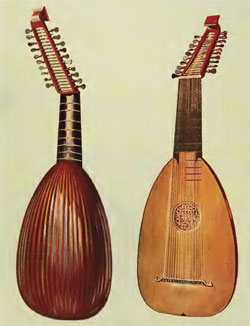
That early style of playing predates the three-finger style used today by nearly all bluegrass banjo players. "This was never a surprise to me, because I have seen this since I was 5 years old." "What struck me was when they mentioned the ball of the thumb and the nail of the index or middle finger, I knew straight away my father was using this same style," Jatta says. When Jatta looked at early banjo instruction books from the mid-1800s, he found that they described an almost identical playing style. Players use the index finger to strike down on one of the long strings, and the thumb sounds the akonting's short string as the hand moves back upward.
#Three stringed instrument skin#
It has a movable wooden bridge that, as in banjos, holds the strings over the skin head.īut for Jatta and other banjo scholars, most convincing is how the akonting is played. It has a long neck that, like those of early banjos, extends through the instrument's gourd body. "Among all the instruments ever mentioned as a prototype of the banjo from the African region," he says, "the akonting to me has more similarities, more objective similarities than any other that has ever been mentioned."įor one thing, the akonting looks like a banjo. Over the next two decades, while he pursued undergraduate and graduate degrees in the U.S., Jatta learned everything he could about the origins of the banjo. Jatta plays an akonting tune written by his father. But they're just two of more than 60 similar plucked stringed instruments found in the region. Much of the speculation has centered on the ngoni and the xalam, two hide-covered stringed instruments from West Africa that bear some resemblance to the banjo. The banjo came to America with the slaves, and musicologists have long looked in West Africa for its predecessors. That experience put Jatta on a journey to explore the banjo's connections with the instrument he grew up with. And the sound just sounded like my father's akonting."

"I watched the program and saw the modern banjo being used. "When the football ended, there was this music program from Tennessee, and they called it country music," Jatta says.
#Three stringed instrument tv#
He recalls watching a football game on TV with some of the other students. from Gambia, attending a junior college in South Carolina. Jatta's father and cousins played the instrument, but he didn't think much about it himself until 1974, when he was visiting the U.S. He's holding an akonting: a three-stringed instrument with a long neck and a body made from a calabash gourd with a goat skin stretched over it. Jatta, 55, is from Gambia, a member of the Jola people.


"My father was born with this instrument," Laemouahuma Daniel Jatta says. Laemouahuma Daniel Jatta plays the akonting, an African instrument that may be a precursor to the banjo.


 0 kommentar(er)
0 kommentar(er)
